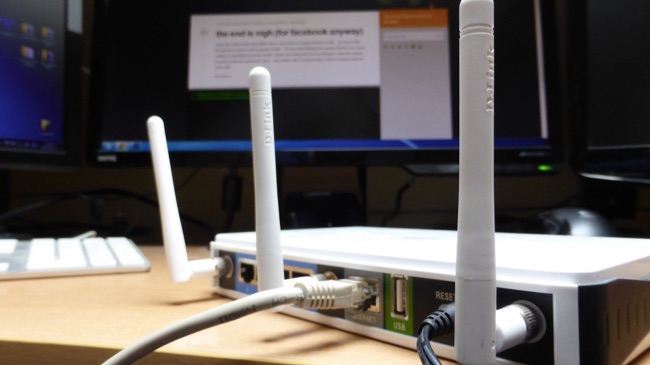What is a wireless router? Everything you need to know about routers and modems
Read our helpful guide to find out how wireless routers are an important piece of the furniture.

What is a wireless router and why is it different to a wireless modem?
It’s easy to get a bit confused about the difference between a wireless router and a wireless modem. This is mainly because they look almost identical!
Put simply, a wireless router allows multiple computers to join the same network and a wireless modem provides access to the internet. As most broadband providers send out combined modem and router boxes, this distinction has become less important. Some users do still utilise two different boxes, however.
If you are using separate boxes, connecting a router to a local area network (LAN) does not provide access to the internet by itself. The router needs to be connected to the modem for that. The modem is the link between your home network and the internet and it connects to your ISP, whether it’s cable or an ADSL service.
The hybrid devices that ISPs generally send out fulfil all these functions but they still work in the same way.
Why you need a router?
A router, or hybrid modem router, is necessary if you want to connect multiple devices to the internet at once.
Wireless routers have evolved over time to become more efficient and effective. With new broadband tariffs and deals, you’ll receive the latest router model from your provider so you can enjoy the benefits of cutting-edge technology.
If a device has a wireless card installed, such as a smartphone, tablet or laptop, you’ll be able to connect to the household WiFi without fiddling around with wires. All you need is the WiFi name and passcode.
Smart TVs can also be linked to your personal wireless connection, so you can watch on-demand programmes and other interactive content. If you have a streaming account with Netflix or Amazon Prime, for example, you will also be able to stream films and shows from your TV with ease.
Here is where a high-quality router or hybrid modem router device does its best work. If a router is not working effectively, or is just not very good, having lots of devices on the network at once can cause service outages as the router struggles to keep up with demand in the home. A good quality router helps keep your home more happy and content!
Router security – How to keep your home network secure and safe
Just like your personal belongings, you should also keep your wireless connection safe and be selective on who you give the passcode to.
A lot of people tend to be very casual about the security of their home network. However, it is very important to remember that having an unsecured home network is the electronic equivalent of leaving your front door wide open so anyone can take your personal possessions. It’s frightening what a malicious individual can see once they get access to your network.
When you receive your router, you will be given a WiFi name and passcode to access your household connection. This is an encryption method which stops unauthorised devices from accessing your broadband.
Most modern routers automatically connect devices that have previously used your personal home connection, which saves time when you want to get online quickly, but also means you should be aware of who you give broadband access to.
Having a unique name and password for your broadband can also lower your chances of your connection being breached. This means the first thing you should do when you get a new router or hybrid modem router is change the default password to something totally unique.
Here are our tips to making sure your home broadband remains safe and secure:
- Only give broadband details to people you know
- Hide all WiFi details in a safe place
- Place your wireless router in a discreet location
The technical bit – how routers, modems and hybrid devices work
Wireless modems and hybrid modem routers are transmitters which connect your home with broadband from your local exchange.
With an ADSL connection, files take longer to download than on fibre-optic. This is because the signal has to take a longer journey, before reaching your wireless router. Your provider will be connected to your local exchange (subject to availability) where signals are sent via a gateway and through wires either underground or above-ground.
Once the signal reaches the exchange, it will then go through BT’s ATM Network, through your property’s signal splitter and then to your router. Your home WiFi will then carry the signal to your connected device.
Alternatively, fibre-optic broadband offers faster download speeds to your home as data is carried through tiny strands of glass, wrapped in thick underground cables and using light beams. This form of broadband is the newest type of connectivity, delivering impressive speeds to your household.
The signal is transmitted through light reflections until it reaches your local cabinet (the green box you find at the end of residential streets). When it hits your green cabinet, the signal is then passed through copper wiring to reach your premises. This process is known as FTTC (fibre to the cabinet).
For even faster speeds, FTTH (fibre to the home) can be fitted so your connection runs straight through to your property. However, this is a costly investment and may not be as widely available as FTTC.
What’s the difference between cable routers and ADSL routers?
There comes a time when an ISP provided router just doesn’t always hit the spot. If you are purchasing a new router it’s essential that you buy the right kit to go with your connection.
If you have a cable connection from a provider such as Virgin Media then you’ll need a cable broadband specific modem and router. You can purchase separate routers that work alongside your ISP kit. If you are just starting out though, it may be worth sticking with a combined cable modem and router to keep things simple.
If you have an ADSL connection you will need an ADSL modem router. An ADSL connection is a non-fibre optic connection from providers such as Sky, BT and TalkTalk. An ADSL modem router combines everything in one box and plugs directly into the phone socket. They are also, in general, very easy to set up and they come with software that will help you get the best from your connection.
Wireless routers with your broadband deal
When you order a broadband package from your chosen provider, you will be given a wireless router for free unless the deal states otherwise.
Some providers may ask that postage and packaging are paid for your router to be delivered, or an engineer will be able to fit your new broadband connection for you.
Every UK provider has their own wireless router and you’ll be given the latest technology with your desired package.
Whether you want a data allowance or unlimited downloads, you’ll be able to choose a home broadband deal that is right for you.
Find a Deal
Last updated on the 3rd of November at 12:11am with 141 deals.







